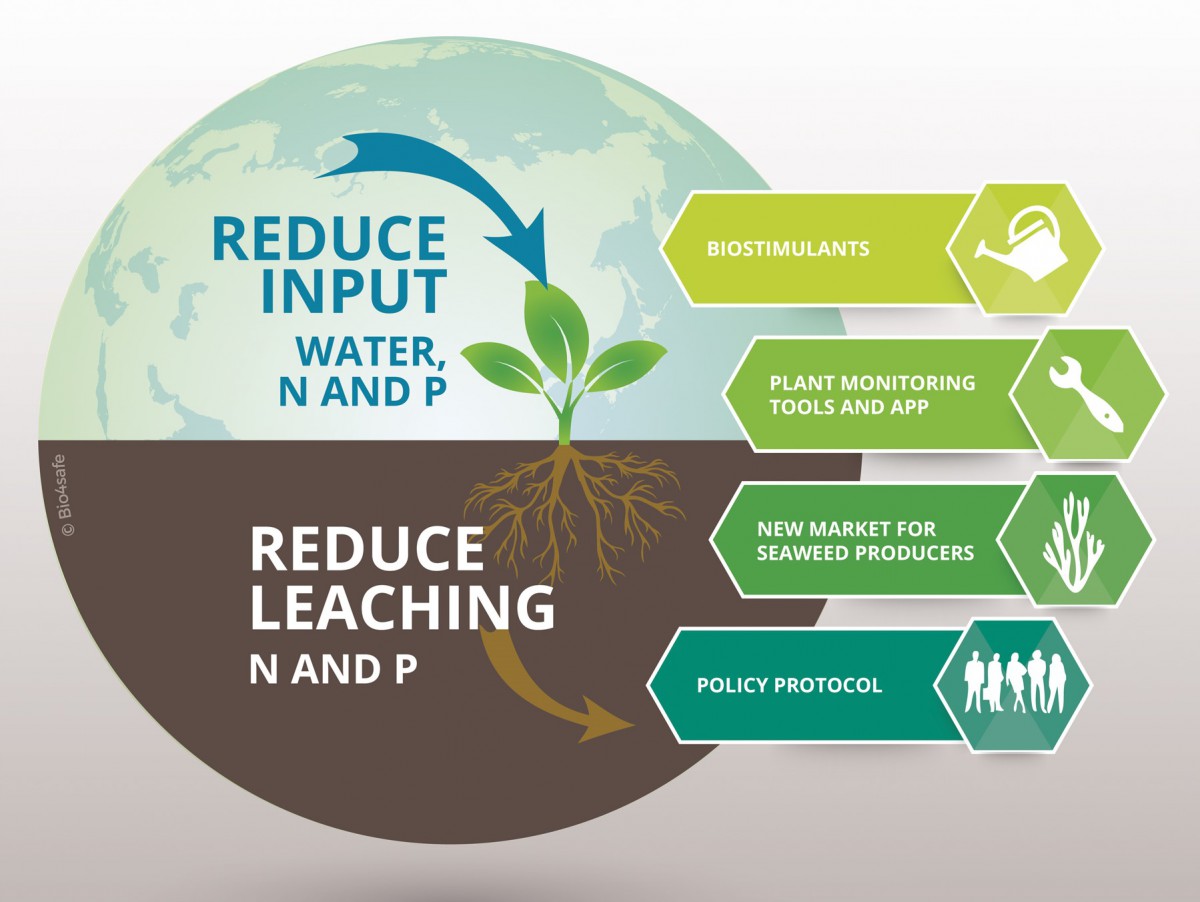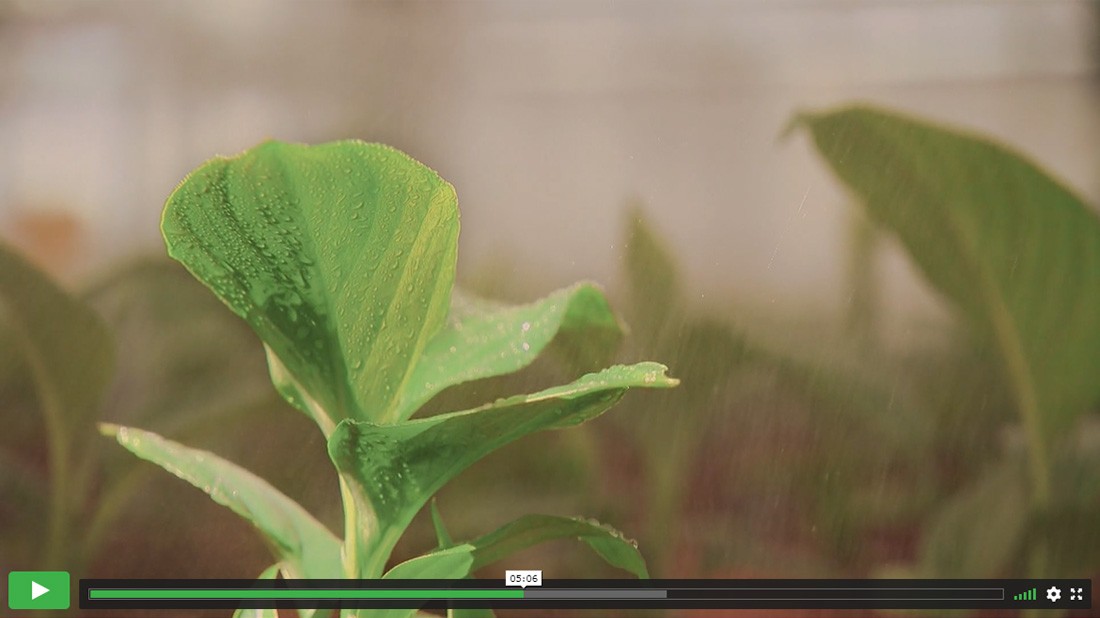
The database is one of the goals of the Bio4safe project (2017-2021) funded by Europe via the Interreg 2 Seas Programme. Bio4safe wants to reduce water and fertilizer use in horticulture (by 20 and 10%, respectively) in the 2 Seas Region (coastal region across the southern North Sea and The Canal) by increasing the use of biostimulants and innovative plant monitoring tools to study the effect of biostimulants on plant responses, writing a policy protocol on how to measure the impact of biostimulants on fertilizer and water use efficiency of plants, and creating economic opportunities for local seaweed producers by studying business cases on biostimulants based on local seaweed.
ReSEARCH results: FIND OUT WHAT WE LEARNED
After a successful international cooperation between universities, research stations and a seaweed organization, we are proud to spread our knowledge and results. We have learned a lot from 5 years of trials with biostimulants and innovative sensors, both at the research stations and with cooperating growers. We combined all relevant biostimulant information in this free and user-friendly database and advised the EU commission on how to make protocols to test new biostimulant products. This and other results you will see in our Bio4safe videos. Have a look at our short trailer video for a short overview of the project results:
1. Ornamental plant research
A green environment is good for your health… Now a green environment is also better for the environment, because we can save water and nutrients during cultivation of ornamentals. Do you want to know how? Then watch the extended video of the Flemish Ornamental Research Centre (PCS). This video is also available with subtitles: English | French.
2. Strawberry and raspberry research
Do you have a sweet tooth for high quality strawberries and raspberries while saving water and nutrients during cultivation? Definitely watch the video of NIAB EMR, the Horticultural Research Centre at East Malling, UK. This video is also available with subtitles: Dutch | French.
3. Vegetable research
Of course we all can eat more veggies from an increased sustainable production with less water and fertiliser use. The video of our partner Pôle Légumes Région Nord from France will show how it's possible.
PUBLICATIONS (2017-2021)
1. VIDEO's
1. What are biostimulants? All around the world farmers are faced with droughts and degraded soil. Up to now the comon reflex is to use fertilisers to restore the soil, but they end up damaging ecosystems and polluting fresh water sources. By using biostimulants the use of water and fertilisers by farmers can be reduced. These stimulants have proven to strengthen crops and restore soil at the same time. A biostimulant is not a crop protection product, but it improves the nutrient use efficiency, tolerance to abiotic stress, crop quality, availability of confined nutrients in soil or rhizosphere. Watch the video 'Biostimulants and the Bio4safe-project' and learn more about biostimulants in horticulture. This video is also available with subtitles: Dutch | French
2. Video innovative seewead based biostimulants from the North Sea: as a non-profit community of businesses with a passion for seaweed, North Sea Farmers work towards positive climate impact. By accelerating and strengthening a sustainable seaweed sector in the Netherlands and Europe, the community aims to improve biodiversity, reduces carbon emissions and is part of the circular economy. One of the ways to do so, is researching the potential of biostimulants based on seaweed: an innovative, locally produced product. In this video, 'The Biostimulant of the Future', the company explains how they work.
3. Video 'Biostimulants and plant sensors in the horticultural sector of tomorrow - The impact of Bio4safe': Producers, researchers, growers and policy makers want to share their experiences with biostimulants with you. Watch their story in the video. This video is also available with subtitles: Dutch | French
4. Demonstration trials with sensors and biostimulants in 2019: this video includes demonstration trials on different horticultural crops (lettuce, tomato, Surfinia, Hydrangea, strawberry, raspberry, tulips, Chrysanthemum) in four different countries to promote the use of biostimulants to diverse target groups. Watch this video about the trials in Dutch:
5. Video Bio4safe: working together on the floriculture sector of tomorrow (2021): In Tournée Provinciale on PlattelandsTV (Belgium), PCS shows that sustainable cultivation is more than ever a necessity due to the changing climate and droughts of recent years. That is why PCS Ornamental Plant Research is looking for solutions in the Bio4safe project to reduce the input of water and fertilizers in horticulture with biostimulants and innovative soil and plant sensors, so that the balance between our ecological footprint and biocapacity increases by decreasing the consumption of natural resources. Watch this video in Dutch:

>> Click here to watch the video.
Also have a look at the interview 'The community determined to make waves with seaweed' with Marlies Draisma (NSF) about the possibilities of seaweed in general and seaweedbased biostimulants.
Click here to have a look at the publications for ornamental growers on the website of PCS Ornamental Plant Research (Dutch).
3. WEBSITE BIO4SAFE.EU
1. Biostimulants database: The database gathers scientific data on plant biostimulants for growers. You can search generally on any search term or you can filter by desired effect, biostimulant type or crop. After searching you get an overview of biostimulants. By clicking on a biostimulant you open the data sheet with information on the biostimulant (type, company), description of the effects, trial details (greenhouse/field trial, stress conditions and country), tested crops, application (method, timing, rate) and source. For optimal use of the database, it is recommended not to use Firefox as webbrowser.
>> Let's have a look at the biostimulants database.
Missing biostimulants? Are you a biostimulant company or researcher and do you have other biostimulants to include in the biostimulant database? Please contact Els Pauwels (PCS) at els.pauwels@pcsierteelt.be.
2. Leaflets with tested sensors: In the Bio4safe project, several plant and soil sensors were used to monitor the presence of drought and/or nutrient stress in plants and to detect effects of the biostimulants. In different leaflets, we collected information about what the sensor can detect, how it can be used, how it works, some pros and cons and the price range. The leaflets are available in English, Dutch and French.
>> Let's have a look at the leaflets with sensors.
3. Trial protocols: During the trial in the Bio4safe project, we gained experience on the use of sensors and biostimulants in different crops under different stress conditions. These experiences have been translated into protocols per crop type for growers on how they can save significant amounts of water and/or fertilizers by using sensors and/or biostimulants. The protocols are available in English, Dutch and French. In a protocol for a specific crop, you can also find the results of the trial that was performed in the project.
Project partners
The project is coordinated by PCS Ornamental Plant Research (BE) and includes 6 other partners:
- Ghent University (BE)
- North Sea Farmers (NL)
- Vertify (NL)
- NIAB-EMR (UK)
- Junia (FR)
- Pôle Légumes (FR)
Also follow the Bio4safe-project on Twitter and have a look at the banner and poster of this Bio4safe-project.
